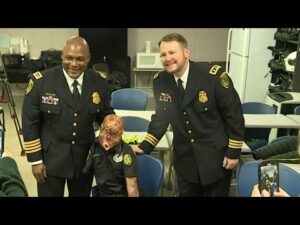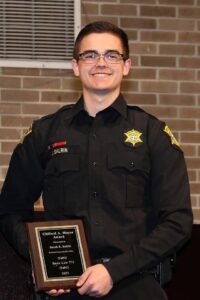Nashville PD’s response to the Covenant School active shooter was ‘by the numbers’
On March 27, an active killer entered the Covenant School in Nashville heavily armed and hunting for children. Officers from the Metropolitan Nashville Police Department responded to a “shots fired” call, immediately entering the school and stopping the killer, who prior to their arrival murdered three young children and three adults.
Although this is a tragedy beyond bearing for the families involved, it is an example to use so that our profession might learn from the police department’s response to this school shooting.
As a trainer, I must state unequivocally that the Nashville police excelled in their response to this tragedy, as demonstrated by the bodycam footage from Nashville Officers Rex Engelbert and Michael Collazo.
By the Numbers: How Nashville PD Excelled in Their Response
Preparation of Police
It is clear that these officers were well-trained for this response in advance. They appeared mentally prepared by demonstrating a calm determination while applying observable learned skills dynamically in a real-world application.
“Long Guns for Long Halls”
As Nashville Officer Rex Engelbert dismounted, he quickly accessed his trunk and acquired his patrol rifle, choosing the right tool for this deadly challenge.
Preparation of School Personnel
School employees showed prior training as well, because as Officer Englebert arrived, a courageous female stood by to pass on critical information that most children were locked down, but two children were unaccounted for.
Another male employee was positioned at a door where he turned a key over to the officers while properly using cover.
Excellent Communication Throughout
Communication throughout the response was professional, effective, and essential. These officers used trained professional terms. It should be noted they not only used verbal communication but also hand signals, which appeared universally understood.
Officers Gathered and Shared Information
Officers were constantly gathering and quickly sharing information.
Identification
The officers announced their presence and authority upon arrival.
Diversion
The officers used the noise present as a diversion to allow them to move to flank the shooter.
Proper Weapons Discipline
Throughout the incident, officers showed excellent weapons discipline, using their muzzle as a “third eye,” controlling muzzle direction while maintaining their fingers off their triggers right up to when the use of deadly force was necessary.
Smooth was Fast
The officers moved quickly as they searched for the killer, but maintained a speed that appeared to be at once fast, but smooth enough to be able to hit what they were shooting at if needed.
Whenever an officer slowed during the search, other officers realizing the urgency instantly communicated that urgency, causing the team to speed up once again. These officers exemplified the old tactical adage “smooth is fast.”
Excellent Building Clearing Skills
Leapfrog
On display was the tactic of leapfrogging as officers moved through the building, making certain the uncleared areas ahead were covered. This was especially noticeable as teams took the stairs.
Proper Use of Cover and Slicing the Pie
The officers were constantly slicing the pie, using cover on the move.
Breacher
A breacher was assigned to breach each door, while another officer had the interior room on the other side of the doorway covered. Entries were smoothly made, usually having the first officer cross and the second buttonhook, announcing “clear” when each room was cleared.
Corners
They could be seen expertly clearing dangerous corners to avoid ambush.
Long Guns Lead
Long guns lead the way throughout up until the last shots were fired.
Secured Perimeter
During the search, officers were placed to hold the cleared area to prevent the shooter from exiting or circling around them.
Officers “Rode to the Sound of the Guns”
The moment the killer was heard to fire at other officers arriving on scene, both teams adjusted to do as the cavalry used to do. They “rode to the sound of the guns.”
Convergence on the Threat
There was communication prior to contact, so both teams conducting the search for the killer knew the location of each team. When the killer opened fire on the officers outside, both teams moved to the sound of fire and converged in a perfect right angle configuration, containing the killer, and avoiding the potential of a cross-fire.
Proper Threat Assessment
When officers located the shooter, the killer appeared to take a firing position behind a decorative chair. From the officers’ vantage point, it was clear the suspect:
- Was in possession of a deadly weapon.
- Had the intent to use that weapon and in fact had already used it, to deliver death or great bodily harm.
- Activated their delivery system, posing an imminent deadly threat to the officers.
The killer made the officer’s use of deadly force a last resort.
Proper Response
Officer Englebert can be seen establishing target acquisition, identification, and isolation, so while using proper trigger control on his weapon, he fired until the killer went down. Englebert paused to re-assess.
As these shots were fired, Officer Collazo’s team converged from the right of the suspect. The suspect went down, but still had access to the weapon and appeared to be moving toward it. Collazo fired as well, communicating “Movement!”
The movement toward the weapon stopped, so all firing stopped, and an arrest team cautiously approached.
Follow-through
With the threat neutralized, the crime scene was cleared and locked down.
Children were sought out and found, while officers took care not to inflict any further trauma. The children were evacuated hand in hand to the nearby church to facilitate reuniting with their families.
Investigators took over the scene.
Victims were located and identified, and family notifications were made.
Release of Public Information
The release of information was done by Nashville Police Chief John Drake. He released as much as he could as soon as he could in a style that humanized police in a laudable manner.
The chief’s release of information, security footage, and body-worn camera footage occurred in near record time while seeming to not jeopardize the investigation.
Conclusion
In watching the body camera footage, when Officer Rex Englebert opened his trunk to acquire his long gun, I noticed the words “Nashville Guardian” on the back of the squad. This incident quite starkly demonstrates a point I have put forward often. That is “when you give someone the proverbial shield of a guardian, sooner or later they will be called upon to draw the sword of a warrior.”
The only way this response could have been improved upon would be if someone who knew the shooter would have come forward during this killer’s earlier fantasy, planning, preparation, or approach phases and reported the shooter, thereby preventing the killing. Sadly, such was not the case.
However, once the “shots fired call” came in, the response by everyone involved appeared to this trainer to be by the numbers, serving as a template for others to follow. This was indeed a job well done!
FAQs
- What were some of the key factors that contributed to the Nashville PD’s successful response?
The officers’ preparedness, excellent communication, proper weapons discipline, smooth yet fast movement, and effective building clearing techniques were all crucial factors that enabled the Nashville PD to handle the situation by the numbers.
- How did the school personnel assist the responding officers?
School employees showed prior training by providing critical information to the officers upon arrival, such as the status of the lockdown and the location of unaccounted children. They also assisted by properly using cover while handing over keys to the officers.
- How did the officers converge on the threat?
Both teams conducting the search for the killer communicated and were aware of each other’s locations. When the killer opened fire on the officers outside, they moved to the sound of fire and converged in a perfect right-angle configuration, containing the killer and avoiding potential crossfire.
- How did the officers assess and respond to the threat?
The officers properly assessed the situation, recognizing the imminent deadly threat posed by the shooter. They established target acquisition, identification, and isolation, and used proper trigger control to neutralize the threat when the killer made the use of deadly force a last resort.
- What was notable about the release of public information by the Nashville Police Department?
Nashville Police Chief John Drake released as much information as possible, as soon as possible, in a manner that humanized the police. He shared security footage and body-worn camera footage in near record time while ensuring the investigation was not jeopardized.




